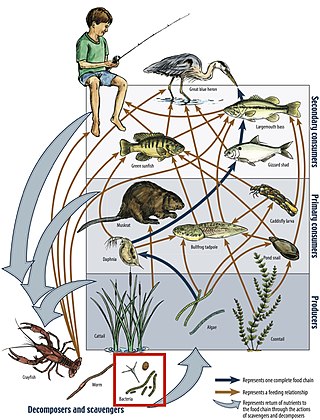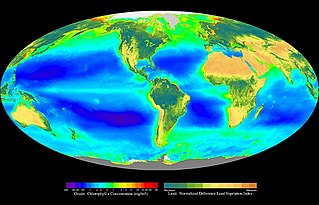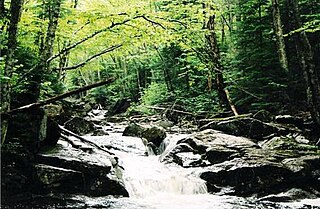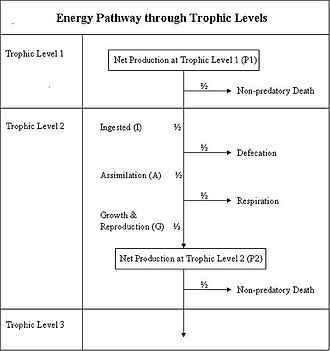
An ecosystem is a system that environments and their organisms form through their interaction. The biotic and abiotic components are linked together through nutrient cycles and energy flows.

Cellular respiration is the process by which biological fuels are oxidized in the presence of an inorganic electron acceptor, such as oxygen, to drive the bulk production of adenosine triphosphate (ATP), which contains energy. Cellular respiration may be described as a set of metabolic reactions and processes that take place in the cells of organisms to convert chemical energy from nutrients into ATP, and then release waste products.

A food web is the natural interconnection of food chains and a graphical representation of what-eats-what in an ecological community. Ecologists can broadly define all life forms as either autotrophs or heterotrophs, based on their trophic levels, the position that they occupy in the food web. To maintain their bodies, grow, develop, and to reproduce, autotrophs produce organic matter from inorganic substances, including both minerals and gases such as carbon dioxide. These chemical reactions require energy, which mainly comes from the Sun and largely by photosynthesis, although a very small amount comes from bioelectrogenesis in wetlands, and mineral electron donors in hydrothermal vents and hot springs. These trophic levels are not binary, but form a gradient that includes complete autotrophs, which obtain their sole source of carbon from the atmosphere, mixotrophs, which are autotrophic organisms that partially obtain organic matter from sources other than the atmosphere, and complete heterotrophs that must feed to obtain organic matter.

In ecology, primary production is the synthesis of organic compounds from atmospheric or aqueous carbon dioxide. It principally occurs through the process of photosynthesis, which uses light as its source of energy, but it also occurs through chemosynthesis, which uses the oxidation or reduction of inorganic chemical compounds as its source of energy. Almost all life on Earth relies directly or indirectly on primary production. The organisms responsible for primary production are known as primary producers or autotrophs, and form the base of the food chain. In terrestrial ecoregions, these are mainly plants, while in aquatic ecoregions algae predominate in this role. Ecologists distinguish primary production as either net or gross, the former accounting for losses to processes such as cellular respiration, the latter not.

Energy flow is the flow of energy through living things within an ecosystem. All living organisms can be organized into producers and consumers, and those producers and consumers can further be organized into a food chain. Each of the levels within the food chain is a trophic level. In order to more efficiently show the quantity of organisms at each trophic level, these food chains are then organized into trophic pyramids. The arrows in the food chain show that the energy flow is unidirectional, with the head of an arrow indicating the direction of energy flow; energy is lost as heat at each step along the way.

The soil food web is the community of organisms living all or part of their lives in the soil. It describes a complex living system in the soil and how it interacts with the environment, plants, and animals.

Ecosystem ecology is the integrated study of living (biotic) and non-living (abiotic) components of ecosystems and their interactions within an ecosystem framework. This science examines how ecosystems work and relates this to their components such as chemicals, bedrock, soil, plants, and animals.
Ecoforestry has been defined as selection forestry or restoration forestry. The main idea of ecoforestry is to maintain or restore the forest to standards where the forest may still be harvested for products on a sustainable basis. Ecoforestry is forestry that emphasizes holistic practices which strive to protect and restore ecosystems rather than maximize economic productivity. Sustainability of the forest also comes with uncertainties. There are other factors that may affect the forest furthermore than that of the harvesting. There are internal conditions such as effects of soil compaction, tree damage, disease, fire, and blow down that also directly affect the ecosystem. These factors have to be taken into account when determining the sustainability of a forest. If these factors are added to the harvesting and production that comes out of the forest, then the forest will become less likely to survive, and will then become less sustainable.

An ecological pyramid is a graphical representation designed to show the biomass or bioproductivity at each trophic level in an ecosystem.

Ecological stoichiometry considers how the balance of energy and elements influences living systems. Similar to chemical stoichiometry, ecological stoichiometry is founded on constraints of mass balance as they apply to organisms and their interactions in ecosystems. Specifically, how does the balance of energy and elements affect and how is this balance affected by organisms and their interactions. Concepts of ecological stoichiometry have a long history in ecology with early references to the constraints of mass balance made by Liebig, Lotka, and Redfield. These earlier concepts have been extended to explicitly link the elemental physiology of organisms to their food web interactions and ecosystem function.

The trophic level of an organism is the position it occupies in a food web. A food chain is a succession of organisms that eat other organisms and may, in turn, be eaten themselves. The trophic level of an organism is the number of steps it is from the start of the chain. A food web starts at trophic level 1 with primary producers such as plants, can move to herbivores at level 2, carnivores at level 3 or higher, and typically finish with apex predators at level 4 or 5. The path along the chain can form either a one-way flow or a food "web". Ecological communities with higher biodiversity form more complex trophic paths.

Soil respiration refers to the production of carbon dioxide when soil organisms respire. This includes respiration of plant roots, the rhizosphere, microbes and fauna.
This is a glossary of environmental science.

An autotroph is an organism that produces complex organic compounds using carbon from simple substances such as carbon dioxide, generally using energy from light (photosynthesis) or inorganic chemical reactions (chemosynthesis). They convert an abiotic source of energy into energy stored in organic compounds, which can be used by other organisms. Autotrophs do not need a living source of carbon or energy and are the producers in a food chain, such as plants on land or algae in water. Autotrophs can reduce carbon dioxide to make organic compounds for biosynthesis and as stored chemical fuel. Most autotrophs use water as the reducing agent, but some can use other hydrogen compounds such as hydrogen sulfide.
In ecology, the term productivity refers to the rate of generation of biomass in an ecosystem, usually expressed in units of mass per volume per unit of time, such as grams per square metre per day. The unit of mass can relate to dry matter or to the mass of generated carbon. The productivity of autotrophs, such as plants, is called primary productivity, while the productivity of heterotrophs, such as animals, is called secondary productivity.
A food chain is a linear network of links in a food web starting from producer organisms and ending at an apex predator species, detritivores, or decomposer species. A food chain also shows how organisms are related to each other by the food they eat. Each level of a food chain represents a different trophic level. A food chain differs from a food web because the complex network of different animals' feeding relations are aggregated and the chain only follows a direct, linear pathway of one animal at a time. Natural interconnections between food chains make it a food web.
Ecometrics is the quantitative analysis of economic, environmental, and societal systems based on the concurrent development of empirical theory, related by appropriate methods of inference in attempts to create more sustainable systems. Broadly defined, Ecometrics is a way to evaluate if an activity is contributing to more sustainable systems of production and consumption. Ecometrics is a system of statistical extrapolation and interpolation that uses principles of resource management in economic and environmental studies to analyze trends in consumption. With a comprehensive understanding of ecometrics, and thereby an understanding of the impacts of specific conscious or conventional opportunity costs, agents within economic systems can cause measurable change for the triple bottom line. The term was originally trademarked by Interface Global, a corporation founded by Ray Anderson. The parameters that cause change are often population, technology, transportation, consumption, public conscious, non-renewable or renewable resources, location, labor conditions, transportation and wealth. Ecometrics is used in labeling programs such as the US EPA Fuel Economy and Environment Label to determine the environmental and financial advantages of purchasing one car over another. There are many applications of Ecometrics for Environmental Impact Calculators infographics, and for political analysis. Because the parameters of ecometrics vary drastically for any activity, the applications of its resulting measurements are sometimes unilateral. Applied ecometrics exposes the complexity of making sustainable decisions, especially given other humanitarian goals such as third world economic development. In this way ecometrics shows any choice within consumption and production systems as wicked problems.
Community respiration (CR) refers to the total amount of carbon-dioxide that is produced by individuals organisms in a given community, originating from the cellular respiration of organic material. CR is an important ecological index as it dictates the amount of production for the higher trophic levels and influence biogeochemical cycles. CR is often used as a proxy for the biological activity of the microbial community.

The viral shunt is a mechanism that prevents marine microbial particulate organic matter (POM) from migrating up trophic levels by recycling them into dissolved organic matter (DOM), which can be readily taken up by microorganisms. The DOM recycled by the viral shunt pathway is comparable to the amount generated by the other main sources of marine DOM.

Compared to terrestrial environments, marine environments have biomass pyramids which are inverted at the base. In particular, the biomass of consumers is larger than the biomass of primary producers. This happens because the ocean's primary producers are tiny phytoplankton which grow and reproduce rapidly, so a small mass can have a fast rate of primary production. In contrast, many significant terrestrial primary producers, such as mature forests, grow and reproduce slowly, so a much larger mass is needed to achieve the same rate of primary production.





















